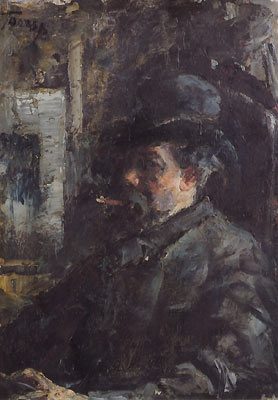
Paul Klee was a Swiss-born German artist. His highly individual style was influenced by movements in art that included expressionism, cubism, and surrealism. Klee was a natural draftsman who experimented with and eventually deeply explored color theory, writing about it extensively; his lectures Writings on Form and Design Theory, published in English as the Paul Klee Notebooks, are held to be as important for modern art as Leonardo da Vinci's A Treatise on Painting was for the Renaissance. He and his colleague, Russian painter Wassily Kandinsky, both taught at the Bauhaus school of art, design and architecture in Germany. His works reflect his dry humor and his sometimes childlike perspective, his personal moods and beliefs, and his musicality.

The Master of the Saint Bartholomew Altarpiece was an Early Netherlandish painter active in Germany, mostly Cologne, between 1475/1480 and 1510. Despite his anonymity, he is one of the most recognizable artists of the early Renaissance period in German art.

The Kolumba is an art museum in Cologne, Germany. It is located on the site of the former St. Kolumba church, and run by the Archdiocese of Cologne. It is one of the oldest museums in the city, alongside the Wallraf-Richartz Museum.
Thomas Reinhold is an Austrian painter, one of the initiators of so-called “New Painting”.
Carl Georg Heise was a German art historian. From 1945 to 1955 he was director of the Kunsthalle Hamburg.

Juno and Argus is a 1610 painting by Peter Paul Rubens, depicting Juno and Argus. It is now in the Wallraf-Richartz Museum in Cologne.

Otto Schwerdgeburth was a German painter and engraver who mainly painted historical subjects.

Johann Anton Alban Ramboux was a German painter and lithographer.

Guillaume Vogels was a Belgian Impressionist painter.
Bettina Baumgärtel is a German art historian who is head of the painting collection of the Museum Kunstpalast in Düsseldorf. She is a leading authority on the art of Angelica Kauffman and founded the Angelika Kauffmann Research Project (AKRP), of which she is the director, in 1990.

The Master of the Karlsruhe Passion is the notname of a German painter of the late Gothic period active in the Upper Rhine. Very influential on other painters in the region, he may be identified with the Strasbourg painter Hans Hirtz. He is named after his main work, the Karlsruhe Passion, though he may also have been the artist behind the murals in the former Dominican church in Strasbourg, only known through two 17th century copies.

Carl Seibels was a German painter in the Biedermeier style.

River Bank in Fog is a c. 1821 oil on canvas painting by Caspar David Friedrich, now in the Wallraf-Richartz-Museum & Fondation Corboud in Cologne, for which it was acquired in 1942 from the Graf Hahn collection at Schloss Basedow (Mecklenburg). It is also known as Elbschiff in Early Fog.
Hans Wilhelm Hupp (1896–1943) was a German art historian, author and curator. From 1933 to 1943 he directed the Museum Kunstpalast of the city of Düsseldorf..

Katja Terlau is a German art historian and provenance researcher. She was a co-initiator and founding member of the international Arbeitskreis Provenienzforschung in Germany, founded in 2000 and is considered a pioneer of German Provenance Research, which she entered after the Washington Principles on Nazi-Confiscated Art of 1998. Her main subject area is looted art; a number of museum holdings and large Jewish collections have been processed by her.
Max Creutz was a German art historian and curator of the Museum für Angewandte Kunst Köln and the Kaiser-Wilhelm-Museum in Krefeld where he worked from 1922 until his death. In Cologne, in 1914 he was instrumental in the first exhibition of the Deutscher Werkbund, Deutsche Werkbundausstellung. In Krefeld, he succeeded in acquiring modern art exhibits, including works by Max Ernst, Wassily Kandinsky, and Alexej von Jawlensky. He included a substantial collection of art, crafts and design from the Bauhaus.
Maria Gertrud Metz(born 1746 in Bonn, died 1793 in London), also known as Gertrude or Gertrudis Metz, was a German still life painter.

The Master of the Legend of Saint Bruno is the "notname" of an anonymous Gothic painter who was active in Cologne in the late 15th century. He is best known for the cycle of paintings on canvas produced for Cologne Charterhouse after which he is named.

Franz Joseph Esser was a German painter, watercolorist, caricaturist, draftsman and graphic artist who was both close to the Cologne Progressives and a member of the Nazi party.

Bleaching on the Lawn is an oil-on-canvas painting executed in 1882–83 by the German painter Max Liebermann. It depicts a scene that takes place in a Dutch cottage garden in Zweeloo, in the province of Drenthe, in North Holland, where several washerwomen are laying out large white linen towels to dry and bleach. The painting is in the collection of the Wallraf-Richartz-Museum, in Cologne.














